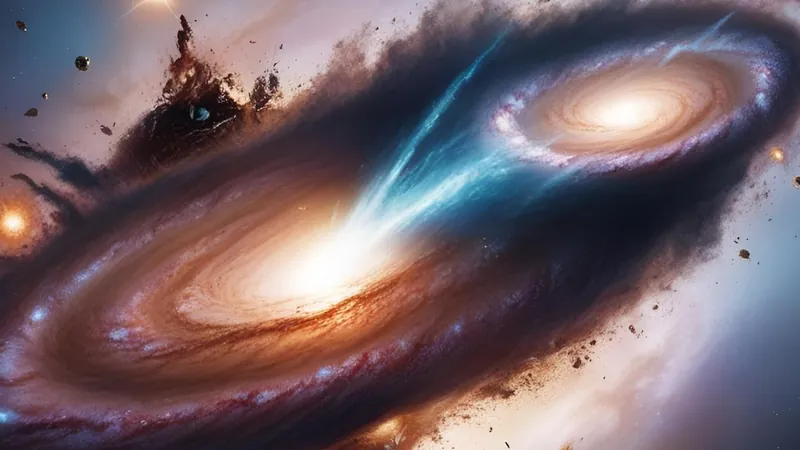
Gravitational Clash: The Large Magellanic Cloud's Devastating Assault on the Small Magellanic Cloud
2025-04-11
Author: Wei
A Cosmic Battle in Our Backyard
In a celestial showdown just outside our Milky Way, two dwarf galaxies, the Large Magellanic Cloud (LMC) and its smaller counterpart, the Small Magellanic Cloud (SMC), are caught in a tumultuous gravitational war. Unfortunately for the SMC, the odds are stacked against it, as it appears to be on a one-way path to destruction.
Shocking Discoveries from Gaia
Utilizing data from the star-tracking Gaia spacecraft, astronomers have made shocking revelations about the SMC. By analyzing the movement of massive stars within this dwarf galaxy, scientists determined that the SMC is being systematically torn apart by the immense gravitational pull of the larger LMC. The fate of the SMC looks grim, but this cosmic drama offers invaluable insights into galactic evolution.
Kengo Tachihara, co-leader of the research team from Nagoya University, expressed his astonishment: "Initially, we suspected an error in our findings, but after thorough examination, the evidence is undeniable. The stars in the SMC are being pulled apart; some are racing towards the LMC while others are fleeing. This supports our theory that the SMC is indeed being disrupted."
The End of the Small Magellanic Cloud?
Thanks to its proximity to our galaxy, Tachihara's team successfully tracked around 700 massive stars within the SMC. These stellar giants, more than eight times the mass of our sun, burn incredibly bright but have short lifespans, expiring in just a few million years compared to our sun's projected 10 billion-year lifetime. Their deaths culminate in spectacular supernova explosions, leaving behind either neutron stars or black holes.
Unusual Stellar Movements
In addition to the bizarre star movements, researchers noted a startling absence of rotational motion among the massive stars in the SMC. Typically, stars form from rotating clouds of gas, but in the SMC, this rotational component seems absent, raising questions about the dynamic processes at play. "If the SMC is indeed not rotating, we may need to reevaluate our understanding of its mass and interactions with the LMC and even the Milky Way," cautioned Satoya Nakano, another co-leader from Nagoya University.
Implications for Galactic Understanding
These discoveries could lead to profound changes in how we model galactic interactions overall. The SMC and LMC share many characteristics with the early galaxies of the universe, offering glimpses into how the cosmos was shaped during its formative years.
As Tachihara poignantly remarked, "We lack a bird's-eye view of our galaxy; thus, the SMC and LMC provide a unique opportunity to scrutinize stellar movement closely. This research is crucial for understanding the intricate relationships between star formation and galactic motion."


 Brasil (PT)
Brasil (PT)
 Canada (EN)
Canada (EN)
 Chile (ES)
Chile (ES)
 Česko (CS)
Česko (CS)
 대한민국 (KO)
대한민국 (KO)
 España (ES)
España (ES)
 France (FR)
France (FR)
 Hong Kong (EN)
Hong Kong (EN)
 Italia (IT)
Italia (IT)
 日本 (JA)
日本 (JA)
 Magyarország (HU)
Magyarország (HU)
 Norge (NO)
Norge (NO)
 Polska (PL)
Polska (PL)
 Schweiz (DE)
Schweiz (DE)
 Singapore (EN)
Singapore (EN)
 Sverige (SV)
Sverige (SV)
 Suomi (FI)
Suomi (FI)
 Türkiye (TR)
Türkiye (TR)
 الإمارات العربية المتحدة (AR)
الإمارات العربية المتحدة (AR)